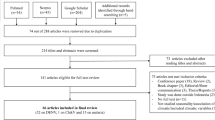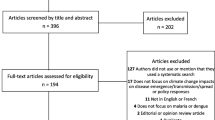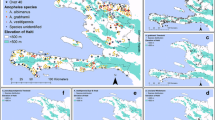Abstract
Climate is an effective factor in the ecological structure which plays an important role in control and outbreak of the diseases caused by biological factors like malaria. With regard to the occurring climatic change, this study aimed to review the effects of climate change on malaria in Iran. In this systematic review, Cochrane, PubMed and ScienceDirect (as international databases), SID and Magiran as Persian databases were investigated through MESH keywords including climate change, global warming, malaria, Anopheles, and Iran. The related articles were screened and finally their results were extracted using data extraction sheets. Totally 41 papers were resulted through databases searching process. Finally 14 papers which met inclusion criteria were included in data extraction stage. The findings indicated that Anopheles mosquitoes are present at least in 115 places in Iran; they are compatible with climatic zones of Iran. Malaria and it’s vectors are affected by climate change. Temperature, precipitation, relative humidity, wind intensity and direction are the most important climatic factors affecting the growth and proliferation of Anopheles, Plasmodium and the prevalence of malaria. The transmission of malaria in Iran is associated with the climatic factors of temperature, rainfall, and humidity. Therefore, with regard to the occurring climatic change, the incidence of the disease may also change which needs to be taken into consideration while planning of malaria control.

Similar content being viewed by others
References
Abeku TA, Van Oortmarssen GJ, Borsboom G, De Vlas SJ, Habbema J (2003) Spatial and temporal variations of malaria epidemic risk in Ethiopia: factors involved and implications. Acta Trop 87:331–340
Anderson PK, Cunningham AA, Patel NG, Morales FJ, Epstein PR, Daszak P (2004) Emerging infectious diseases of plants: pathogen pollution, climate change and agrotechnology drivers. Trends Ecol Evol 19:535–544
Babaie J, Fatemi F, Ardalan A, Mohammadi H, Soroush M (2014) Communicable diseases surveillance system in east Azerbaijan earthquake: strengths and weaknesses. PLoS Curr 6
Babaie J, Ardalan A, Vatandoost H, Goya MM, Akbarisari A (2015a) Performance assessment of communicable disease surveillance in disasters: a systematic review. PLoS Curr 7
Babaie J, Ardalan A, Vatandoost H, Goya MM, Sari AA (2015b) Performance assessment of a communicable disease surveillance system in response to the twin earthquakes of east azerbaijan. Disaster Med Public Health Prep 9:367–373
Barati M, Keshavarz-Valian H, Habibi-Nokhandan M, Raeisi A, Faraji L, Salahi-Moghaddam A (2012) Spatial outline of malaria transmission in Iran. Asian Pac J Trop Med 5:789–795
Barati M, Salahi Mogadam A, Azizi M (2014) Assessment of malaria status in Iran. Paramed Sci Mil Health 2:9–13
Barati M, Khoshdel A, Salahi-Moghaddam A (2015) An overview and mapping of anopheles in Iran. Paramed Sci Mil Health 10:9–16
Barber BE, Rajahram GS, Grigg MJ, William T, Anstey NM (2017) World malaria report: time to acknowledge plasmodium knowlesi malaria. Malar J 16:135
Bayoh M, Lindsay S (2003) Effect of temperature on the development of the aquatic stages of anopheles gambiae sensu stricto (diptera: culicidae). Bull Entomol Res 93:375–381
Beck-Johnson LM, Nelson WA, Paaijmans KP, Read AF, Thomas MB, Bjørnstad ON (2013) The effect of temperature on Anopheles mosquito population dynamics and the potential for malaria transmission. PLoS ONE 8:e79276
Beck-Johnson LM, Nelson WA, Paaijmans KP, Read AF, Thomas MB, Bjørnstad ON (2017) The importance of temperature fluctuations in understanding mosquito population dynamics and malaria risk. Open Sci 4:160969
Bi P, Tong S, Donald K, Parton KA, Ni J (2003) Climatic variables and transmission of malaria: a 12-year data analysis in Shuchen County, China. Public Health Rep 118:65
Bouma M, Van Der Kaay H (1994) Epidemic malaria in India and the El Nino southern oscillation. Lancet 344:1638–1639
Caminade C, Kovats S, Rocklov J, Tompkins AM, Morse AP, Colón-González FJ, Stenlund H, Martens P, Lloyd SJ (2014) Impact of climate change on global malaria distribution. Proc Natl Acad Sci 111:3286–3291
Change IC (2007) The fourth assessment report of the intergovernmental panel on climate change, Geneva, Switzerland
Epstein PR (2000) Is global warming harmful to health? Sci Am 283:50–57
Epstein PR (2001) Climate change and emerging infectious diseases. Microbes Infect 3:747–754
Epstein PR, Diaz HF, Elias S, Grabherr G, Graham NE, Martens WJ, Mosley-Thompson E, Susskind J (1998) Biological and physical signs of climate change: focus on mosquito-borne diseases. Bull Am Meteor Soc 79:409–417
Floor WM (2004) Public health in Qajar Iran. Mage Publishers, Washington
Gao H-W, Wang L-P, Liang S, Liu Y-X, Tong S-L, Wang J-J, Li Y-P, Wang X-F, Yang H, Ma J-Q (2012) Change in rainfall drives malaria re-emergence in Anhui Province, China. PLoS One 7:e43686
Haghdoost A (2004) Assessment of seasonal and climatic effects on the incidence and species composition of malaria by using GIS methods. University of London, London
Hales S, De Wet N, Maindonald J, Woodward A (2002) Potential effect of population and climate changes on global distribution of dengue fever: an empirical model. Lancet 360:830–834
Halimi M, Delavari M, Takhtardeshir A (2013) Survey of climatic condition of Malaria disease outbreak in Iran using GIS. J Sch Public Health Inst Public Health Res 10:41–52
Halimi M, Farajzadeh M, Delavari M, Bagheri H (2014) Climatic Survey of Malaria Incidence in Iran during 1971–2005. J Sch Public Health Inst Public Health Res 12:1–11
Halimi M, Zarei Cheghabalehi Z, Jafari Modrek M (2016) Impact of El Niño Southern Oscillation (ENSO) on Annual Malaria Occurrence in Iran. Iran J Health Environ 9:369–382
Holakouie Naieni K, Nadim A, Moradi G, Teimori S, Rashidian H, Kandi Kaleh M (2012) Malaria epidemiology in Iran from 1941 to 2006. J Sch Public Health Inst Public Health Res 10:77–90
Houghton J, Firor J (1995) Global warming: the complete briefing. Cambridge University Press, Cambridge
Huang F, Zhou S, Zhang S, Wang H, Tang L (2011) Temporal correlation analysis between malaria and meteorological factors in Motuo County, Tibet. Malar J 10:54
Jadgal KM, Zareban I, Alizadeh siouki H, Sepehrvand N (2014) The Epidemiological features of Malaria in Konarak, Iran (2007–2011). J Torbat Heydariyeh University Med Sci 2:54–60
Kim Y-M, Park J-W, Cheong H-K (2012) Estimated effect of climatic variables on the transmission of Plasmodium vivax malaria in the Republic of Korea. Environ Health Perspect 120:1314
Kovats R, Campbell-Lendrum D, Mcmichel A, Woodward A, Cox JSH (2001) Early effects of climate change: do they include changes in vector-borne disease? Philos Trans R Soc Lond B Biol Sci 356:1057–1068
Kovats RS, Bouma MJ, Hajat S, Worrall E, Haines A (2003) El Niño and health. Lancet 362:1481–1489
Kuhn KG, Campbell-Lendrum DH, Armstrong B, Davies CR (2003) Malaria in Britain: past, present, and future. Proc Natl Acad Sci 100:9997–10001
Kumar P, Reddy NNR (2014) Factors affecting malaria disease transmission and incidence: a special focous on Visakhapatnam district. Int J Sci Res 5:312–317
Lardeux FJ, Tejerina RH, Quispe V, Chavez TK (2008) A physiological time analysis of the duration of the gonotrophic cycle of Anopheles pseudopunctipennis and its implications for malaria transmission in Bolivia. Malar J 7:141
Lindblade KA, Walker ED, Onapa AW, Katungu J, Wilson ML (1999) Highland malaria in Uganda: prospective analysis of an epidemic associated with El Nino. Trans R Soc Trop Med Hyg 93:480–487
Lindsay SW, Bødker R, Malima R, Msangeni HA, Kisinza W (2000) Effect of 1997–98 EI Niño on highland malaria in Tanzania. Lancet 355:989–990
Mabaso ML, Sharp B, Lengeler C (2004) Historical review of malarial control in southern African with emphasis on the use of indoor residual house-spraying. Tropical Med Int Health 9:846–856
Martens W, Niessen LW, Rotmans J, Jetten TH, Mcmichael AJ (1995) Potential impact of global climate change on malaria risk. Environ Health Perspect 103:458
Mills JN, Gage KL, Khan AS (2010) Potential influence of climate change on vector-borne and zoonotic diseases: a review and proposed research plan. Environ Health Perspect 118:1507
Mohammadkhani M, Khanjani N, Bakhtiari B, Sheikhzadeh K (2016) The relation between climatic factors and malaria incidence in Kerman, South East of Iran. Parasite Epidemiol Control 1:205–210
Moradi A, Akhtarkavan M, Ghiasvand J, Akhtarkavan H (2008) Assessment of direct adverse impacts of climate change on Iran. earth 11:16
Mozafari GA, Mostofialmammaleki R (2012) Bioclimatic analysis of the malaria disease outbreak in Chabahar city. Geographic space. 12:21–37
Mozaffari GA, Hashemi A, Safarpour F (2011) The effect of southern oscillation on malaria disease in Iran with emphasis on the town of Chabahar. J Arid Reg Geogr Stud 1:53–65
Ostfeld RS, Brunner JL (2015) Climate change and Ixodes tick-borne diseases of humans. Philos Trans R Soc B 370:20140051
Parry M, Canziani O, Palutikof J, Van Der Linden PJ, Hanson CE (2007) Climate change 2007: impacts, adaptation and vulnerability. Cambridge University Press, Cambridge
Patz JA, Campbell-Lendrum D, Holloway T, Foley JA (2005) Impact of regional climate change on human health. Nature 438:310–317
Piao S, Ciais P, Huang Y, Shen Z, Peng S, Li J, Zhou L, Liu H, Ma Y, Ding Y (2010) The impacts of climate change on water resources and agriculture in China. Nature 467:43–51
Raeisi A, Nikpoor F, Ranjbar Kahkha M, Faraji L (2009) The trend of Malaria in IR Iran from 2002 to 2007. Hakim Res J 12:35–41
Rahimi D, Morianzadeh J (2016) Analysis of the impact climate and ENSO on the malaria in Kerman province. J Nat Environ Hazards 5:17–30
Rodó X, Pascual M, Doblas-Reyes FJ, Gershunov A, Stone DA, Giorgi F, Hudson PJ, Kinter J, Rodríguez-Arias M-À, Stenseth NC (2013) Climate change and infectious diseases: Can we meet the needs for better prediction? Clim Change 118:625–640
Salahimoghadam A, Khoshdel A, Barati M, Sedaghat MM (2014) An overview and mapping of Malaria and its vectors in Iran. Bimon J Hormozgan Univ Med Sci 18:428–440
Salahi-Moghaddam A, Khoshdel A, Dalaei H, Pakdad K, Nutifafa GG, Sedaghat MM (2017) Spatial changes in the distribution of malaria vectors during the past 5 decades in Iran. Acta Trop 166:45–53
Shemshad K, Oshaghi M, Yaghoobi-Ershadi M, Vatandoost H, Abaie M, Zarei Z, Jedari M (2007) Morphological and molecular characteristics of malaria vector Anopheles superpictus populations in Iran. Tehran Univ Med J TUMS Publ 65:6–13
Smith KR, Corvalán CF, Kjellstrom T (1999) How much global ill health is attributable to environmental factors? Epidemiol Baltim 10:573–584
Soleimani Ahmadi M, Vatandoost H, Shaeghi M, Raeisi A, Abedi F, Eshraghian MR, Aghamolaei T, Madani AH, Safari R, Jamshidi M, Alimorad A (2012) Effects of educational intervention on long-lasting insecticidal nets use in a malarious area, southeast Iran. Acta Med Iran 50:279–287
Teklehaimanot HD, Lipsitch M, Teklehaimanot A, Schwartz J (2004) Weather-based prediction of Plasmodium falciparum malaria in epidemic-prone regions of Ethiopia I. Patterns of lagged weather effects reflect biological mechanisms. Malar J 3:41
Trenberth KE (2001) Climate variability and global warming. Science 293:48–49
Wang M, Overland JE (2004) Detecting Arctic climate change using Köppen climate classification. Clim Change 67:43–62
Wangdi K, Singhasivanon P, Silawan T, Lawpoolsri S, White NJ, Kaewkungwal J (2010) Development of temporal modelling for forecasting and prediction of malaria infections using time-series and ARIMAX analyses: a case study in endemic districts of Bhutan. Malar J 9:251
WHO (2005) Using climate to predict infectious disease epidemics/Communicable Diseases Surveillance and Response, Protection of the Human Environment, Roll Back Malaria
WHO (2015) World malaria report 2015. World Health Organization
WHO (2017) World malaria report 2017. World Health Organization
Wu X, Tian H, Zhou S, Chen L, Xu B (2014) Impact of global change on transmission of human infectious diseases. Sci China Earth Sci 57:189–203
Wu X, Lu Y, Zhou S, Chen L, Xu B (2016) Impact of climate change on human infectious diseases: empirical evidence and human adaptation. Environ Int 86:14–23
Yeryan M, Basseri HR, Hanafi-Bojd AA, Raeisi A, Edalat H, Safari R (2016) Bio-ecology of malaria vectors in an endemic area, Southeast of Iran. Asian Pac J Trop Med 9:32–38
Zhang Y, Bi P, Hiller JE (2010) Meteorological variables and malaria in a Chinese temperate city: a twenty-year time-series data analysis. Environ Int 36:439–445
Author information
Authors and Affiliations
Corresponding author
Rights and permissions
About this article
Cite this article
Babaie, J., Barati, M., Azizi, M. et al. A systematic evidence review of the effect of climate change on malaria in Iran. J Parasit Dis 42, 331–340 (2018). https://doi.org/10.1007/s12639-018-1017-8
Received:
Accepted:
Published:
Issue Date:
DOI: https://doi.org/10.1007/s12639-018-1017-8




